Nikon 1 Nikkor VR 30-110mm f/3.8-5.6 Review

Introduction
The Nikon 1 Nikkor VR 30-110mm f/3.8-5.6 is a telephoto zoom lens for the new Nikon 1 system. Constructed of a whopping 18 elements arranged in 12 groups, the Nikon 1 Nikkor 30-110mm f/3.8-5.6 VR features a collapsible-barrel design, mechanically coupled zoom ring, Vibration Reduction and an iris diaphragm with seven rounded blades. With a 35mm equivalent focal range of approximately 80-300mm, the Nikon 1 Nikkor VR 30-110mm f/3.8-5.6 features two ED glass elements, ultra-fast and silent auto-focus operation and an extremely compact and lightweight construction for superior portability. The lens is available in a double-zoom kit with the Nikon 1 V1 and Nikon 1 J1 cameras, or separately for $249.
Ease of Use
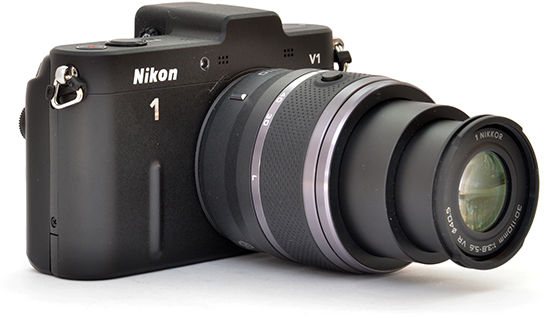 The 1 Nikkor 30-110mm lens mounted to a Nikon 1 V1 camera body
The 1 Nikkor 30-110mm lens mounted to a Nikon 1 V1 camera body
The Nikon 1 Nikkor VR 30-110mm f/3.8-5.6 is among the very first lenses announced for the brand new Nikon 1 system, which is built around a so-called CX format sensor that's considerably smaller than a regular Four Thirds imager. Weighing in at a mere 180 grams and measuring just 60x61mm when retracted, the 1 Nikkor VR 30-110mm lens is 10 grams lighter and considerably smaller than its Micro Four Thirds (MFT) equivalent, the Olympus M.Zuiko Digital ED 40-150mm f/4-5.6.
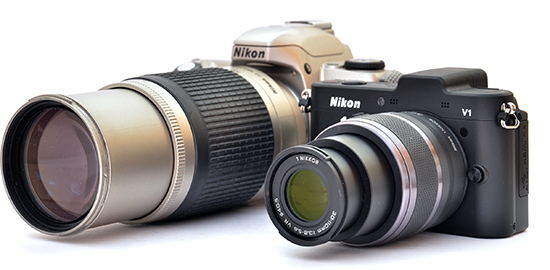 Size matters – the 1 Nikkor 30-110mm vs. the AF Nikkor 70-300mm at full telephoto
Size matters – the 1 Nikkor 30-110mm vs. the AF Nikkor 70-300mm at full telephoto
The difference is even more striking vis-a-vis one of the 1 Nikkor's closest 35mm equivalent stable-mates, the AF Nikkor 70-300mm f/4-5.6, shown here mounted to a Nikon F65 film SLR body.
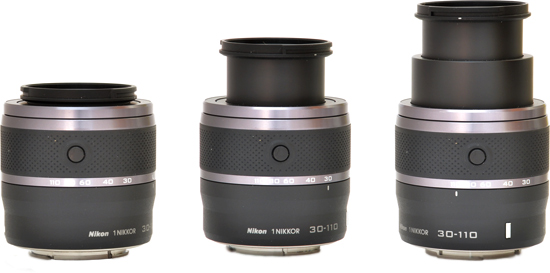 Retracted, zoomed out and zoomed in
Retracted, zoomed out and zoomed in
The Nikon 1 Nikkor VR 30-110mm f/3.8-5.6 features a collapsible-barrel design similar to that employed in some Olympus MFT lenses (though not the 40-150mm mentioned above). This means that when the lens is not in use, you can store it in a space-saving retracted position. When you need to shoot with it, all you need to do is depress the zoom ring button and extend the lens to the 30mm position (assuming it's already attached to the camera, of course). This also causes the camera to turn itself on, with no need to press the power button on the camera body you are using. The 1 Nikkor 30-110mm features a double barrel nest that extends as you zoom in, but the lens remains remarkably compact even at full telephoto. Build quality is good, with the lens feeling surprisingly solid for its size and price tag.

In terms of features, the Nikon 1 Nikkor 30-110mm f/3.8-5.6 VR is a rather unusual offering. It has Vibration Reduction but there are no controls for it, as you can turn it on and off via the camera's menu (with the “on” options being Normal and Active). You also get a choice of auto and manual focus, but there is no focus ring, and no focus mode switch either. Switching between AF and MF is also done via the camera's user interface, and you need to use the camera's rear-mounted scroll wheel to focus the lens manually, which may be unusual if you're used to SLR lenses.
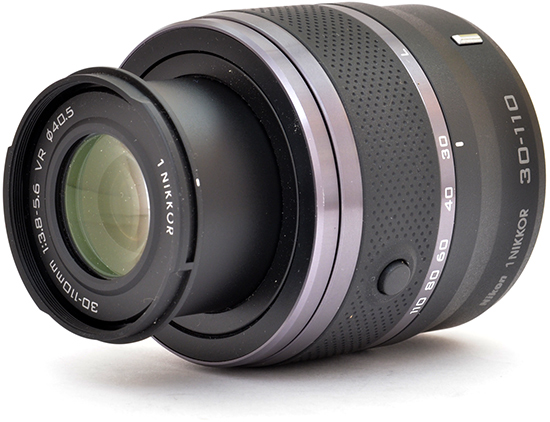 Front of lens, isometric view
Front of lens, isometric view
The Nikon 1 Nikkor 30-110mm f3.8-5.6 VR lens takes small 40.5mm filters and ships with a dedicated HB-N103 bayonet hood and a tiny snap-on lens cap. Given its size, it easily fits in a coat pocket or almost any photo bag. If you want added protection, Nikon will be happy to sell you the optional CL-N101 soft case for about $20.
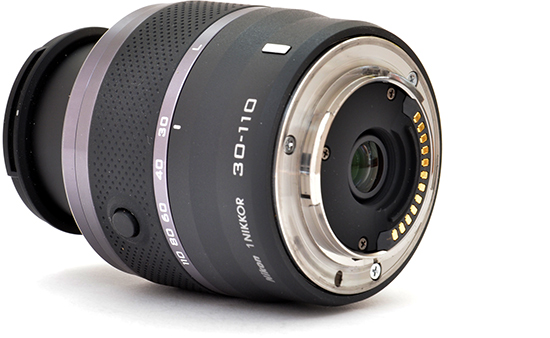 Rear of lens, isometric view
Rear of lens, isometric view
The lens is outfitted with a solid metal bayonet mount and a dozen electrical contacts that provide 100% electronic communication with the camera body.
Focal Range
Due to the 2.72x “crop factor” of the Nikon CX sensor the lens has been designed for, the Nikon 1 Nikkor VR 30-110mm f3.8-5.6 has a 35mm equivalent focal range of 81.6-299.2mm.
At the 30mm end of the zoom range, the angle of view is 29°40', which is a wee bit tighter than that of an 80mm lens mounted to an FX or 35mm film camera.
 Field of view at 30mm
Field of view at 30mm
At the 110mm end, the angle of view narrows to 8°20’, which is essentially the same as that of a 300mm lens in a full-frame system.
 Field of view at 110mm
Field of view at 110mm
Focusing
One of the biggest claims Nikon has made about the 1 System was that it has the fastest AF in the world. Now, we've heard that claim before from other companies so we were naturally curious to find out how this particular lens behaved in this respect. We're pleased to report that in good light, the 1 Nikkor 30-110mm lens, mounted to a Nikon 1 V1 body, does indeed focus extremely quickly, and not just on stationary subjects. With the focus mode set to continuous AF, the combo has a remarkable capability of keeping fast-moving subjects in focus, even during burst shooting (as long as you do not set a frame rate that's faster than 10fps on the camera, that is). Among our sample images, you can see a number of photos taken at a local kids' football match and a few others that show a young and energetic herding dog running toward the camera at full speed. Most camera-lens combos and compact cameras would focus on the background in these situations, but the 1 Nikkor 30-110mm VR f3.8-5.6 did a remarkable job of keeping the actual subject in focus most of the time.
In low light, the 1 System cameras will resort to contrast-detect auto focus. This focusing method is slower than the phase-difference detection used in good light, so do not expect the lens to achieve the same level of performance. Low-light shooting pretty much requires your subject to stand still.
As mentioned above, manual focusing is also possible, even though the lens does not have a focus ring. To focus manually, you first need to set the focus mode to MF on the camera, then use the scroll wheel for focusing. This isn't the most intuitive method and you will likely to find it strange if you're coming from the SLR world. Also, while the camera offers a magnified display to aid you with getting the focus right, the magnification seems interpolated and is thus a lot less helpful than it could be with a better implementation.
Chromatic Aberrations
Chromatic aberrations, typically seen as purple or blue fringes along contrasty edges, are basically a non-issue with this lens. There's only a hint of CA along contrasty edges, which is not field relevant at all.

Light Fall-off
With the lens fully zoomed to 110mm, there is a very small amount of light fall-off in the extreme corners, but it's really nothing to worry about in everyday shooting.

Macro
The Nikon 1 Nikkor 30-110mm f/3.8-5.6 VR is not a macro lens. The minimum focus distance is 1m, and the maximum reproduction ratio is 1:10. The following example demonstrates how close you can get to your subject, in this case a Compact Flash card.
 Close-up performance
Close-up performance
Bokeh
Bokeh is a word used for the out-of-focus areas of a photograph, and is usually described in qualitative terms, such as smooth / creamy / harsh etc. In the 1 Nikkor VR 30-110mm f/3.8-5.6, Nikon emplyed an iris diaphragm with 7 rounded blades for a smooth bokeh. We have found that when you can throw the background sufficiently out of focus, the lens does indeed produce a pleasing bokeh but your subject needs to be quite close and the background quite far away for that. Otherwise the result can be a little “nervous” for our tastes.
 |
 |
 |
 |
Sharpness
In order to show you how sharp this lens is, we are providing 100% crops on the following pages.
